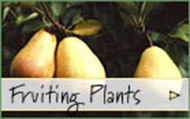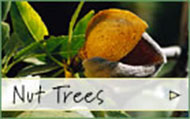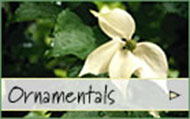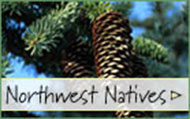NSTEWIN
|
|
 |
| LABRADOR TEA WINTER CREEK (Rhododendron groenlandicum) |
| A hardy evergreen flowering shrub. Aromatic leaves are used, fresh or dried to make a pleasant tasting tea. Leaves can also be chewed or added to beer to make it more heady. Winter Creek has an especially long bloom period with a mass of white star shaped flowers. Tolerates wet sites, this shrub is under 3 foot in height with a spreading habit. Zone 3-8 |
|
|
NSNSMOC
|
|
 |
| MOCK ORANGE (Philadelphus lewisii) |
| Large, fragrant white flowers cover these medium sized, multi-stemmed shrubs in late June. Native to western North America. Shredding bark and yellow fall color are also attractive features. Mock Orange is sure to attract bees and butterflies. Hardy to -25°F. Zone 4. |
|
|
NSNSNOO
|
|
 |
| NOOTKA ROSE (Rosa nutkana) |
| Large pink flowers and big red rose hips. Sweet scented. Widely adapted Pacific Northwest native to dry or moist sites. Nootka Roses make for good for hedgerows and wildlife plantings. Zone 5-8. |
|
|
NSNSOCE
|
|
 |
| OCEAN SPRAY (Holodiscus discolor) |
| Native to western North America commonly found in the understory. Ocean Spray blooms in mass. Clusters of small white flowers turn deep cream over time. Mildly fragrant flowers attract bees, butterflies and beneficial insects. Arching branches, a large shrub that grows 10-20 ft. Also called 'Ironwood' because of its strong wood. Zone 5-10. |
|
|
NSNSORE
|
|
 |
| OREGON GRAPE (Mahonia aquifolium) |
| Pretty evergreen understory shrub, 3 - 5 ft. tall. Native to the Pacific Northwest, Oregon Grape will naturalize itself unless if the suckers are removed. Bright yellow spring flowers with very tart blue berries. Leaves commonly used in floral arrangements. Glossy green serrated leaves reminiscent of holly leaves turn reddish purple over winter. Zone 5-8. |
|
|
NSNSOSO
|
|
 |
| OSO BERRY (Oemlaria cerasaformis) |
| Typically a 10-foot shrub or small tree with hardy, bell shaped male or female white flowers in late winter. Purple fruits in late spring are ½" long and seedy but edible. Oso Berry is formerly known as Indian plum. Oval leaves have a cucumber scent. Widely adapted to sun or shade. Zone 6-8 |
|
|
NSNSPOU
|
|
 |
| POULSBO SCARLET FLOWERING CURRANT (Ribes sanguineum) |
| Showy Northwest native. A very upright, multi-stemmed shrub, this selection has intense, deep red dangling clusters of flowers which are very showy in early spring. Hummingbirds visit flowers and songbirds like to eat the sparse, inspid fruits. One of the earliest hummingbird nectar plants. Sun or shade. Poulsbo Scarlet Currant grows to be a 5-10 ft. reliable shrub. Zone 6-9. CAN NOT SHIP TO NC/MA |
|
|
NSNSRDFL
|
|
 |
| RED FLOWERING CURRANT (Ribes sanguineum) |
A showy Pacific Northwest native shrub that grows to about 5-10 ft. Stunning red tubular flowers in early spring that are visited by hummingbirds and butterflies.
Songbirds will eat the fruits of Red Flowering Currant. Sun or shade. Zone 5-7.
CAN NOT SHIP TO NC, MA |
|
|
NSNSRDHUC
|
|
 |
| RED HUCKLEBERRY (Vaccinium parvifolium) |
| Very shade tolerant northwest native shrub. Produces pretty pink to red edible berries the size of a small blueberry. Tart and refreshing in midsummer. Needs soil high in organic matter. Red Huckleberry grows to about 6 ft. |
|
|
NSNSRED
|
|
 |
| RED OSIER DOGWOOD (Cornus sericea) |
| Dense, flat-top clusters of white blossoms in spring which later drape down and become tipped with white berries. Dark green leaves change to burgundy in autumn and shine scarlet in sunlight. Amazing wildlife value as a food source to a range of birds, beneficial insects and mammals. An important larval host to the Spring Azure Butterfly. Red stems are brilliant against a snowy background in winter. Fast growth rate is great in mass planting landscapes, hedges or use as a winter interest specimen. Plant 3-4' apart in a hedge. Full sun to partial shade. Zone 3-7. |
|
|
NSNSRUS
|
|
 |
| RUSSET BUFFALOBERRY (Shepherdia canadensis) |
| Also known as soapberry. Widely adapted nitrogen fixing shrub with small yellow flowers and juicy red berries. Russet buffaloberry differs from regular Buffaloberry in that this shrub is thornless, but the berries, while edible, are more bitter. This species is native to Washington along Puget Sound and is also found in Coastal Alaska and Western British Columbia, though it is more common in the Intermountain West. Zone 2-7 |
|
|
NSNSSAL
|
|
 |
| SALAL (Gaultheria shallon) |
| Understory native shrub with edible black fruit growing in clusters. Blueberry sized berries are a traditional staple food of Northwest Coastal Indians. Can be eaten fresh, cooked, or dried. Salal makes an excellent jelly. Stems with large evergreen leaves used in floral arrangements. In sun, will be about 2 ft. tall; in shade up to 6 ft. Zone 7-9. |
|
|

 Click here to view items for:
Winter / Spring (Jan-June)
Summer (July-Oct)
Fall (Nov-Dec)
Click here to view items for:
Winter / Spring (Jan-June)
Summer (July-Oct)
Fall (Nov-Dec)




















